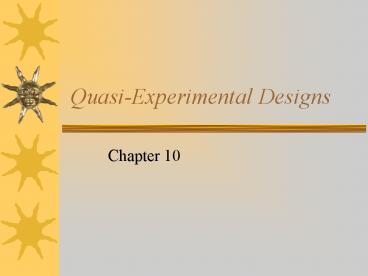QuasiExperimental Designs - PowerPoint PPT Presentation
1 / 13
Title:
QuasiExperimental Designs
Description:
Goal of determining causation. Where the research is being ... Experimental expectancy effects and the Hawthorne effect. Specific Quasi-Experimental Designs ... – PowerPoint PPT presentation
Number of Views:26
Avg rating:3.0/5.0
Title: QuasiExperimental Designs
1
Quasi-Experimental Designs
- Chapter 10
2
Comparison with True Experiments
- Goal of determining causation
- Where the research is being conducted
- laboratory versus natural settings
- Intervention or treatment ? IV
- More control in true experiments
- Randomly assignment to the levels of IV
- Appropriate comparison -- Simplest, two groups
treated exactly alike except for the IV
3
External Validity
- Some research (e.g., cognitive, physiological,
theory development, etc.) the setting doesnt
matter -- basic research - Quasi-experiments in natural settings allows for
increased generalizability critical to
intervention research (applied research) --
practical goals
4
Obstacles to True Experiments
- Access and permission to study
- Permission to randomly assign ethical issues,
especially when talking about a treatment - Could offer the treatment to the control group if
found to be of benefit
5
Threats to Internal Validity
- History
- Events other than the treatment confound the
effect of IV - Different experiences between groups
- Can control variables that are potential
confounds, but that is more difficult with
quasi-experiments - Maturation
- Participants change over time
- Challenge to determine if change due to IV,
especially in pre- post-test designs - Need appropriate control group to be more
confident due to IV
6
History
- Testing
- Experience and familiarity with testing
procedures can effect DV (pre- post-test designs) - Instrumentation
- Changes over time due to instruments (including
the researcher) used to measure - Can control with clear operational definitions
and/or calibrating machines regularly
7
- Statistical regression
- Regression towards the mean when select based on
extreme scores - Low scores will be inflated because initially
depressed due to error (chance or other factors) - High scores will be depressed because initially
inflated due to error - Selection
- Random assignment minimizes differences between
groups or averages those differences - More challenging in natural settings
8
- Subject mortality
- Attrition changes the equivalence between
groups - Could be due to the IV
- Interactions with selection
- Any of the other threats interacts with selection
- Changes in freshmen may be greater than changes
in sophomores maturation and selection - history and selection different effect on one
group compared to other (e.g., principle changes) - Instrumentation and selection (ceiling and floor
effects)
9
And even more problems
- Contamination
- Communication between groups about the experiment
can result in -- resentment, demoralization,
rivalry (especially with intact groups),
diffusion of treatments - External validity
- Representativeness of sample
- Generalizing across persons, settings, and times
we rarely use random sampling - Could even be difference between extra credit
versus required participation - Replication is key
- Experimental expectancy effects and the Hawthorne
effect
10
Specific Quasi-Experimental Designs
- Lack of randomization is hallmark
- Need to be careful with causal interpretations
- One-group Pre-test and post-test design O1 X O2
no internal validity - Non-equivalent control group measure pre- and
post-test in two groups one gets treatment, the
other is the control - O1 X O2
- O1 O2
11
example
- Type of communication given to elderly adults in
nursing home
12
Interrupted Time Series
- O1 O2 O3 O4 X O5 O6 O7 O8
- Only assess abrupt changes because of small
natural fluctuations - Interrupted time series with nonequivalent
control group - Can address differences between groups on pretest
by computing an ANCOVA analysis of covariance
13
(No Transcript)































